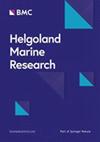Progress and perspectives in the discovery of polychaete worms (Annelida) of the world
4区 地球科学
Q2 Agricultural and Biological Sciences
引用次数: 36
Abstract
Despite the availability of well-documented data, a comprehensive review of the discovery progress of polychaete worms (Annelida) has never been done. In the present study, we reviewed available data in the World Register of Marine Species, and found that 11,456 valid species of Recent polychaetes (1417 genera, 85 families) have been named by 835 first authors since 1758. Over this period, three discovery phases of the fauna were identified. That is, the initial phase (from 1758 to mid-nineteenth century) where nearly 500 species were described by few taxonomists, the second phase (from the 1850’s to mid-twentieth century) where almost 5000 species were largely described by some very productive taxonomists, and the third phase (from the 1950’s to modern times) in which about 6000 species were described by the most taxonomists ever. Six polychaete families with the most species were Syllidae (993 species), Polynoidae (876 species), Nereididae (687 species), Spionidae (612 species), Terebellidae (607 species) and Serpulidae (576 species). The increase in the number of first authors through time indicated greater taxonomic effort. By contrast, there was a decline in the number of polychaete species described in proportion to the number of first authors since around mid-nineteenth century. This suggested that it has been getting more difficult to find new polychaete species. According to our modelling, we predict that 5200 more species will be discovered between now and the year 2100. The total number of polychaete species of the world by the end of this century is thus anticipated to be about 16,700 species.世界多毛纲蠕虫(环节动物)的发现进展与展望
尽管有充分的文献资料,但从未对多毛类蠕虫(环节动物)的发现进展进行过全面的回顾。本研究通过对《世界海洋物种名录》资料的分析,发现自1758年以来,已有835位第一作者命名的现代多毛类(1417属,85科)11456种有效物种。在此期间,确定了动物群的三个发现阶段。也就是说,在最初阶段(从1758年到19世纪中叶),只有少数分类学家描述了近500个物种;在第二阶段(从1850年代到20世纪中叶),一些非常多产的分类学家大量描述了近5000个物种;在第三阶段(从1950年代到现代),大约6000个物种被有史以来最多的分类学家描述。种类最多的6个多毛纲科依次为:水蛭科(993种)、多毛纲科(876种)、细毛纲科(687种)、蛛科(612种)、细毛纲科(607种)和细毛纲科(576种)。随着时间的推移,第一作者数量的增加表明了更大的分类努力。相比之下,自19世纪中期以来,多毛类物种的数量与第一作者的数量成比例下降。这表明发现新的多毛类物种变得越来越困难。根据我们的模型,我们预测从现在到2100年将发现5200多个物种。因此,到本世纪末,世界上多毛类物种的总数预计约为16,700种。
本文章由计算机程序翻译,如有差异,请以英文原文为准。
求助全文
约1分钟内获得全文
求助全文
来源期刊

Helgoland Marine Research
地学-海洋学
自引率
0.00%
发文量
0
审稿时长
6-12 weeks
期刊介绍:
Helgoland Marine Research is an open access, peer reviewed journal, publishing original research as well as reviews on all aspects of marine and brackish water ecosystems, with a focus on how organisms survive in, and interact with, their environment.
The aim of Helgoland Marine Research is to publish work with a regional focus, but with clear global implications, or vice versa; research with global emphasis and regional ramifications. We are particularly interested in contributions that further our general understanding of how marine ecosystems work, and that concentrate on species’ interactions.
 求助内容:
求助内容: 应助结果提醒方式:
应助结果提醒方式:


